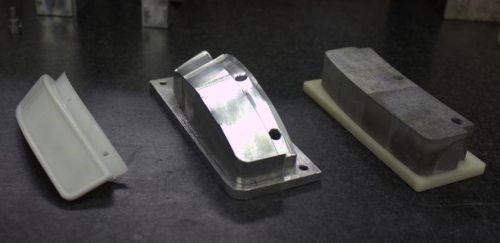Moldmaker Speeds Production with 3D-Printed Fixtures
A 3D printer helps this mold manufacturer save time and money in making custom fixturing.
Share







Mold manufacturer prides itself on working closely with customers to prototype and help refine the design of products before building the molds. Its Maker Gear M2 3D printer helps with this service, enabling the shop to quickly turn out prototypes. But the printer is also used in production. 3D-printed custom supports and workholding fixtures have saved the shop money and time in turning around its moldmaking work.
The image above depicts one example. The plastic injection-molded part on the left is a component for a feed auger, used to push product up and out of a chute. The piece was designed to be held in place with two stainless steel rivets pressed into the two holes and attached to the auger via rare earth magnets.
The angle of the holes combined with the curve of the part made it necessary to build the B side of the injection mold in three parts, so that they could be removed without damaging the features. Holding this section of the mold for machining in the shop’s sinker EDM proved to be a challenge; aside from consisting of multiple pieces, this portion of the mold offered no parallel sides for clamping. A custom 3D-printed fixture (visible on the right) held the parts together and provided the necessary straight edges.
Read more about how .
Related Content
-
Video: Apply Metal and Machine It With Hermle’s Metal Powder Application (MPA) Process
The Metal Powder Application (MPA) process uses cold spray to apply metal to an existing workpiece. Because the material deforms rather than melts, MPA opens new possibilities for functional grading and other multimaterial applications.
-
Chuck Jaws Achieve 77% Weight Reduction Through 3D Printing
Alpha Precision Group (APG) has developed an innovative workholding design for faster spindle speeds through sinter-based additive manufacturing.
-
OEMs Showcase Hybrid Manufacturing Applications
Mazak and Mastercam worked together to demonstrate the viability of hybrid additive/subtractive machining techniques at a recent event held in Florence, Kentucky.
.jpg;width=70;height=70;mode=crop)











